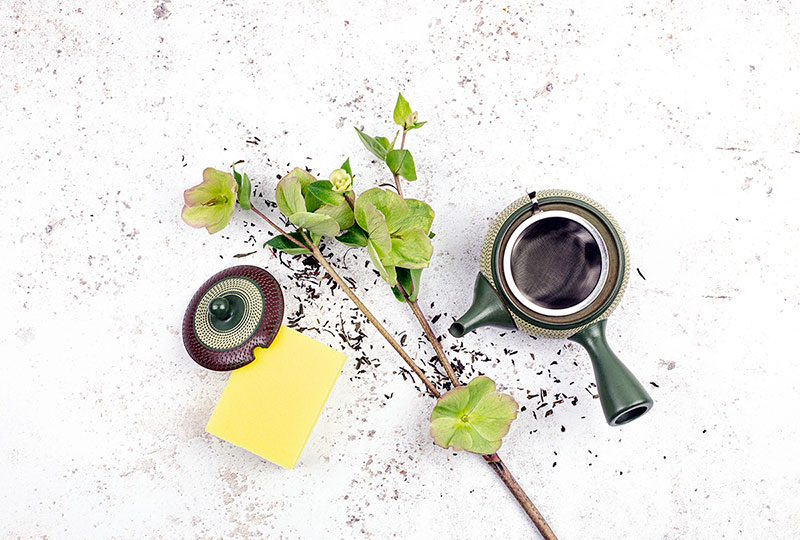How to Clean Your Tea Kettle and Utensils
Nothing tastes worse than a high-quality tea made in an unclean or rusted tea pot. For making a perfect cup, cleaning your teaware properly is as important as having quality tea. Learn how to take care of your tea utensils and find out what you should never do with your teapots.
General tips for tea utensil cleanliness
If you really want to enjoy your cup of tea, you should always use clean utensils. Utensils include smaller pieces of tea equipment such as strainers, brewing baskets or infusers, and bigger teaware such as teapots, mugs and cups and kettles. Some may be easier to clean than others. Not only will cleaning them properly have a huge influence on the flavor of your tea, but it will prolong their lifespan and help you save money.
1. Always clean your utensils after use
Teapots, infusers and strainers should all be cleaned immediately after use. Even if you are using the same leaves two times or more, never leave them in your teapot for longer than several hours. Keeping tea leaves inside teapot will create a brown film that may not always be cleaned easily. Dry them before storing them.
2. Non-porous materials are easier to clean
If you are concerned about cleanliness of your teaware, non-porous ceramic or glass may be a better choice than porous ceramics. For example, glass is dishwasher safe. Spouts of some teapots will be almost impossible to clean unless you use a dishwasher, which makes easier to clean. Some teapots, such as Japanese kyusu or Chinese yixing zisha teapots, should never be washed in a dishwasher, or even using detergents. It will take more effort to keep them spotlessly clean.
3. Use the best teapot for your needs
Teapots with build-in metals strainers may be very difficult to clean. If you are a tea beginner, teapots with removable stainless steel, ceramic or glass infusers will be easier to handle. You may wash them in a dishwasher too.
4. Remove tea leaves and clean with hot water
Once you are finished with brewing, always remove tea leaves from your teapots and wash them with hot or boiling water. Use detergents only for stainless steel, glass, or non-porous ceramics.
5. Have a separate teapot for different types of tea
Every teapot made from a porous material, no matter how much you will clean it, will develop a thin film over time. Use a separate teapot for lighter teas and a separate one for stronger. For example, don’t brew Earl Grey black tea in the same teapot you would use for Silver Needle or Dragon Well tea.
6. Use a toothpick, toothbrush or cotton buds
If your teapot has a build-in metal mesh strainer, such as sesame kyusu, you may use a toothpick to remove small pieces of stuck tea leaves. Alternatively, you can use a clean wet toothbrush too. Spouts may be cleaning using cotton buds. It’s important to clean spout too.
7. Use a clean sponge
Build-up inside your unglazed teapot may be cleaned with a sponge or a damp cloth. However, always use a new gentle sponge or have a separate sponge for your teaware only.
8. Dry it
After washing your teapot or teaware, use a soft cloth to dry it. Don’t put a lid of wet teapot and make sure it’s completely dry before putting it away.
How to clean your tea kettle
Having a clean kettle is as important as having a clean teapot. Over some time, you will see mineral deposits in your kettle. Deposits come from minerals in hard water, and they will accumulate faster from tap water. Using spring water will leave less residue.
Clean your electric kettle regularly, at least once per month, even if you are using spring water. Just like teapots, kettles should not be cleaned using detergents. Although there are several kettle cleaning products on the market, they will mostly contain ingredients you may already have at home. Never use products for removing limescale that are made for cleaning bathrooms, sinks or tiles. The best natural and safe ways to clean kettle are:
1. Citric acid
Citric acid is the simplest, cheapest and the best product to clean your kettle. Simply fill your kettle half full with water and bring it to a boil. Open the lid and add 1 spoon of citric acid. Be careful not to burn yourself with steam. Cover the lid and let it rest for 10 to 20 minutes. Then bring water to a boil again and leave for another 10 minutes. Pour the water out and wash it with clean water.
2. Lemon juice
You may use lemon juice and water to clean your kettle instead of citric acid. Slice the lemon, add water and lemon slices into your kettle and bring it to a boil. Let it sit for 30 minutes. Bring it to a boil again. Remove lemon slices and pour out the water and wash it with clean water.
3. White vinegar
White vinegar is another product that may be used for cleaning your kettle. However, it will leave more scent than lemon. Simply add equal parts of white vinegar and water to your kettle and bring it to a boil. Let it sit for a couple of hours. Pour the water out and wash with clean water thoroughly until the scent is gone.
4. Bicarbonate of soda
Bicarbonate of soda or baking soda is not only great for making pink tea, you can use it for cleaning a kettle too. Fill the kettle half full and add 1-2 teaspoons of bicarbonate of soda. Bring it to a boil and let solution to sit for 30 minutes. Pour the water out and wash the kettle.




